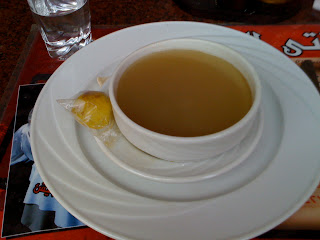
The first time we ate Koshari was in one of the more fancy dining establishments on Cairo's Zamalek island, a green safe haven between the banks of the Nile, for wealthy ex-pats or ambassadors. There, at Abou-el-Sid restaurant, it was delicious, but from hereafter, we were to find the true experience of it, which I think has a lot to do with the informal, canteen style set up of a classic Koshari house.
With some time to kill before boarding our train from Luxor to Aswan, we found a 'KOSHARI' sign in amongst the string of ahwas, spice shops and (weirdly) lots and lots of chemists on the main drag towards the station. We were greeted with quite a few odd looks, and were apparently very unwelcome sitting in the dark room downstairs so we lugged our big backpacks up to the first floor and took a seat. A waiter soon came to take our order - other than koshari we ordered some lamb shawerma with flatbread. This was good, very juicy and flavoursome however the metal bowl full of carby grains was the highlight. The mixture consists of rice, brown lentils, macaroni and sometimes chickpeas. This is served with a tomato sauce which is to be poured over, and bottles of lemon vinegar and spicier chilli sauce usually adorn tables to add as you like.
On our final day in Egypt, back in Cairo after a week of travelling around the country, we made a koshari pilgrimage to Abou Tarek, one of the most favoured places in the city. At over four storeys high, it seemed that rather than open at multiple locations in the city the building had just grown to accomodate their popularity. The face of Mr. Tarek himself was emblazoned on the sides of the building with a welcoming smile. Even before we entered, we could see the dish being prepared in all its different constituents, having to move out of the way for men carrying huge vats of wobbling pasta from across the street, with piles of pre-crisped onions awaiting being scattered on top.

Each establishment will have its slight variation - here, longer pieces of spaghetti were included making it seem more like a pasta dish than a warm grainy salad. The main dish is usually served in these metal bowls - I liked the flashes of blue on the accompanying crockery. Certainly many Egyptians would call it a national dish, despite its bizarre mixture of elements that make it strikingly multicultural. It is interesting to imagine how the dish came about, other than as the perfect amalgamation of leftovers. The name though relates to the Indian and Pakistani dish Khichri (which gave us our kedgeree), that dates back to the 15th century. Scooping up mouthfuls of it, you can see why the simple combination of seasoned pulses and a variety of bright or spicy additions has crossed continents and stayed popular for so long. Similarly, it is refreshing noticing that despite how cheap it is, the diner-like metal tables of places like Abou Tarek and our Luxor koshari house see a range of customers - families, old men, groups of girls, even well-dressed couples on romantic lunchtime dates. And as we found with our original experience of it, it has even worked its way onto the menus of more up-market locations, perhaps with the same thinking that has brought pork belly, offal and other cheap cuts of meat to the fanciest of London restaurants. Who knows, maybe someone will even open a koshari house there.














